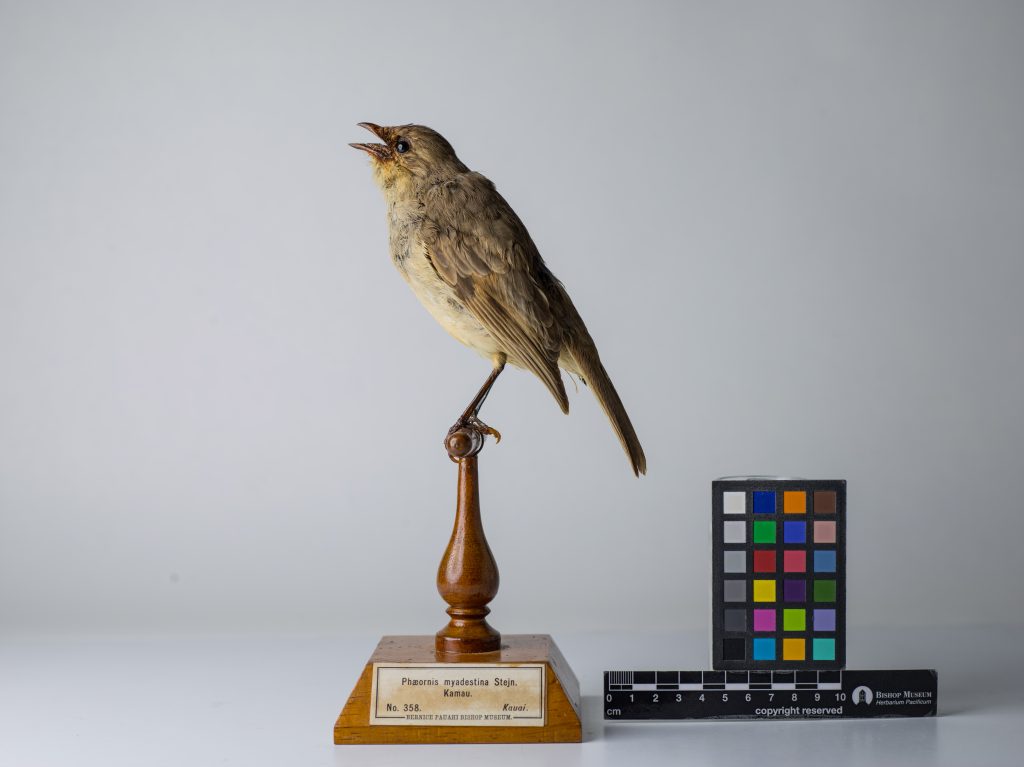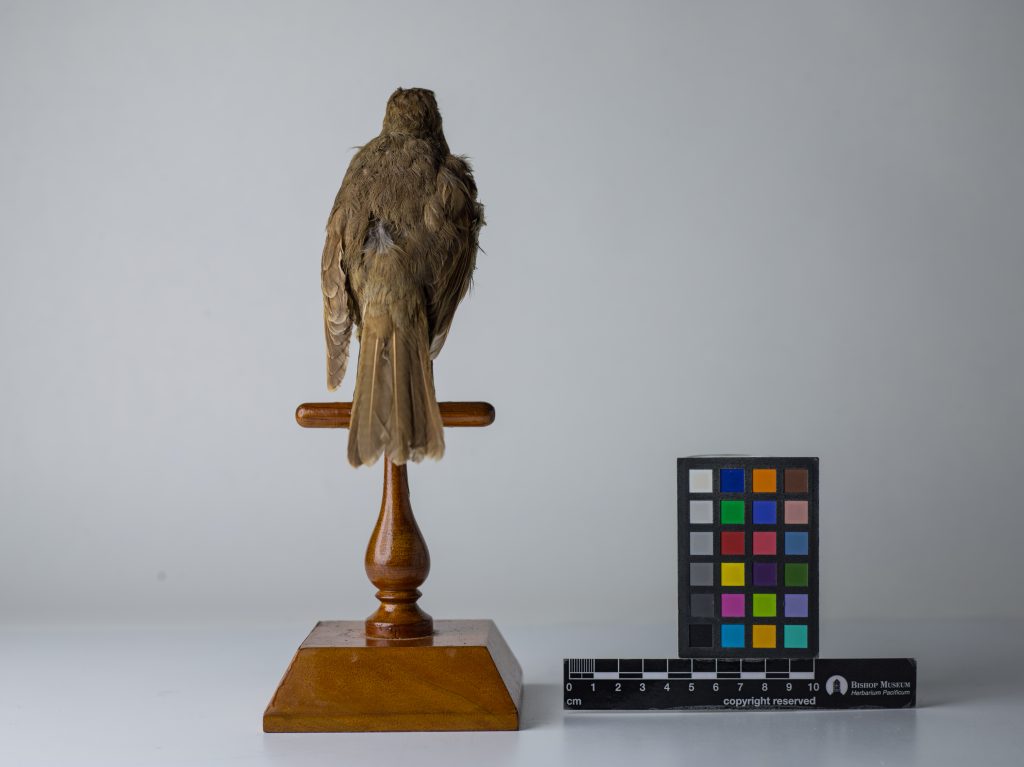Kāmaʻo
Names
- ʻŌlelo Hawaiʻi: Kāma‘o
- Common: Large Kaua‘i Thrush
- Scientific: Myadestes myadestinus
Conservation Status
Extinct. Last seen in the wild in 1987.
Species Information
The kāma‘o, or large Kaua‘i thrush, is one of two Hawaiian solitaires (family: Turdidae) endemic to Kaua‘i. The species was noted for flying upward, singing a few loud notes, and then suddenly dropping into the under the forest canopy. Like all adult Hawaiian solitaires, the kāma‘o has olive-brown and gray plumage, but it lacks the white-eye ring and pinkish legs of the smaller puaiohi or small Kaua‘i thrush (M. palmeri). The species’ complex song is composed of a melodic series of liquid warbles, trills, and whistles, and is often heard before dawn and after dusk. The diet is reported to consist of fruits and berries, particularly the bracts of ‘ie‘ie (Freycinetia arborea). Life history characteristics are mostly unknown, but are presumed similar to the ‘ōma‘o (M. obscurus). Breeding is thought to occur in spring, although no nest has been described.
Distribution
Has not been observed below 1,100 meters (3,500 feet) since the mid-1960s. If the species persists, it is concentrated in
the uppermost regions of the Alaka‘i Wilderness Preserve. Historically was found in moist forests near sea level on northern Kaua‘i as well as upland, interior mountain forests.
Habitat
Most recent sightings were in open canopy forests of ‘ōhi‘a (Metrosideros polymorpha) and ‘ōlapa (Cheirodendron spp.). Based on the diet and life history of the ‘ōma‘o, a diverse understory including epiphytes, tree ferns, and fruiting plants such as ‘ie‘ie, ‘ōhā wai (Clermontia spp.), and ‘ōhelo (Vaccinium spp.) would likely be high-quality habitat. Because ‘ie‘ie, an important food plant, does not do well in highelevation forests, if the species persists it may be restricted to marginal habitat. The area where the species was last observed is managed by the State of Hawai‘i as a Wilderness Preserve.
Threats
Kāma‘o are likely susceptible to the same factors that threaten other native Hawaiian forest birds, including loss and degradation of habitat, predation by introduced mammals, and disease. For kāma‘o, the following are of particular concern:
- Disease. Mosquito-borne disease is probably the most important factor in the decline of the kāma‘o. Pox lesions were noted on this species in mid-19th century.
- Habitat degradation. The presence of native forest with abundant fruit-bearing plants below the species current range demonstrates that habitat degradation cannot entirely explain the species extirpation from lowland areas. However, several invasive plants and feral pigs (Sus scrofa) have degraded the understory of many native forests.
- Competition. Non-native birds, especially ecologically similar species (e.g., whiterumped shama [Copsychus malabaricus]), may have contributed to the species’ decline.
- Predation. If kāma‘o, like many solitaires, are cavity or low platform nesters, their nests would be very susceptible to rats (Rattus spp.).
- Non-native arthropods. Recently introduced non-native insects, especially yellow jackets (Vespula pensylvanica) and Argentine ants (Linepithema humile), may compete with the kāma‘o’s native arthropod prey or disrupt the pollination of the species’ food plants. Introduced herbivorous insects also could reduce the abundance of food plants.
Photos
Additional Resources
Pyle, R.L., and P. Pyle. 2017. The Birds of the Hawaiian Islands: Occurrence, History, Distribution, and Status. B.P. Bishop Museum, Honolulu, HI, U.S.A. Version 2 (1 January 2017) http://hbs.bishopmuseum.org/birds/rlp-monograph
For more information and references visit the DLNR State Wildlife Action Plan factsheets. DOFAWʻs species pages and State Wildlife Action Plan fact sheets are provided for general information and are not meant to be a citable, original source of data. If you are a student, researcher, or writer looking for a citable source, please explore the references below or find other original data sources, rather than citing these webpages. The references below were provided by the authors of the State Wildlife Action Plan fact sheets at the time of drafting:
- Foster JT, Tweed EJ, Camp RJ, Woodworth BL, Adler CD, Telfer T. 2004. Long-term population changes of native and introduced birds in the Alaka‘i swamp, Kaua‘i. Conservation Biology 18:716-725.
- IUCN Red List of Threatened Species. 2015. Version 2014.3. Available at: www.iucnredlist.org. (Accessed May 2015).
- Scott JM, Mountainspring S, Ramsey FL, Kepler CB. 1986. Forest bird communities of the Hawaiian islands: their dynamics, ecology and conservation. Lawrence, (KS): Cooper Ornithological Society.
- U.S. Fish and Wildlife Service. 2006. Revised Recovery plan for Hawaiian forest birds. Portland, (OR): U.S. Fish and Wildlife Service.
- Wakelee KM, Fancy SG. 1999. ‘Oma‘o (Myadestes obscurus), kama‘o (Myadestes myadestinus), oloma‘o (Myadestes lanaiensis), and ‘amaui (Myadestes woahensis). In The Birds of North America, No. 460 (Poole A, Gill F, editors.). Philadelphia, (PA): The Academy of Natural Sciences; and Washington DC: The American Ornithologists’ Union.




